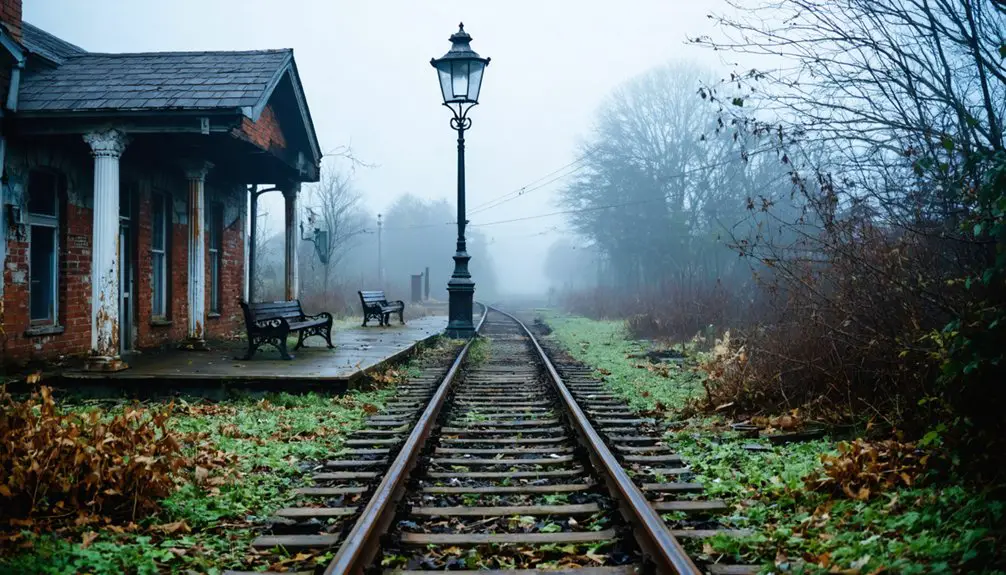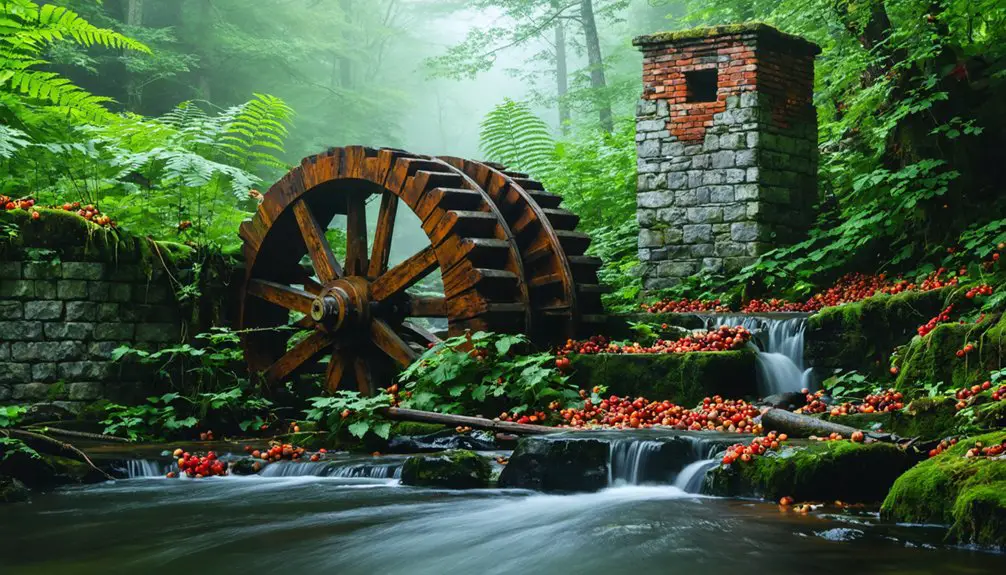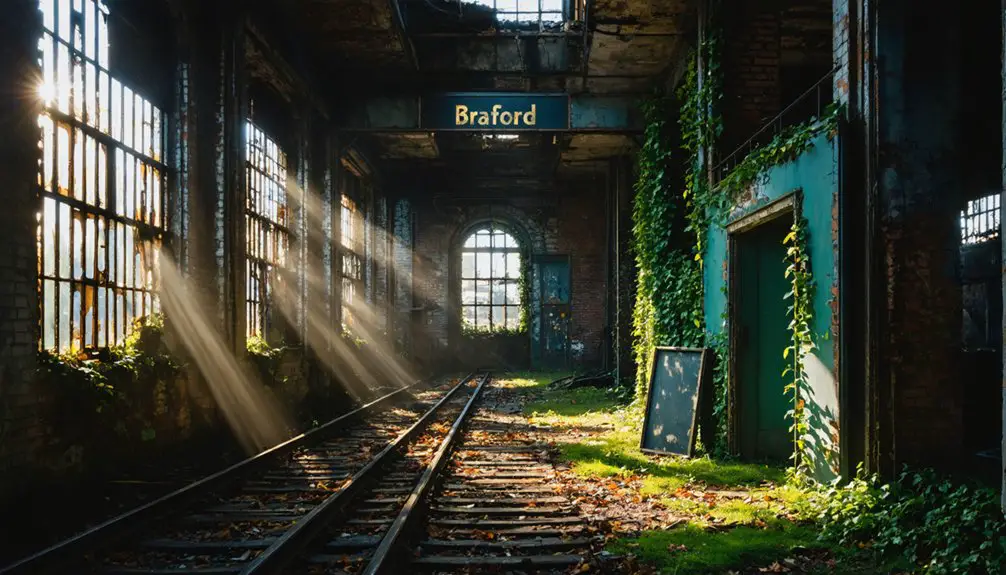You’ll discover the haunting remains of Carolina Station tucked away in Richmond, Rhode Island, where this once-bustling 19th-century railroad hub now stands as one of New England’s most evocative ghost towns. During its peak, the station served 70,000 monthly passengers and featured distinctive red brick architecture with granite accents. Today, nature reclaims the weathered walls and stone foundations, while urban explorers document its industrial heritage through hidden forest trails. The site’s rich history holds countless untold stories within its crumbling walls.
Key Takeaways
- Carolina Station was a major 19th-century Rhode Island railroad hub between Providence and Worcester that supported textile and manufacturing industries.
- The station declined by mid-20th century due to automotive transportation growth, leading to its abandonment by 1959.
- Notable architectural features include red brick buildings with granite details, cast-iron storefronts, and twelve-over-twelve windows.
- The ghost town’s remains include stone foundations, weathered walls, and empty buildings now overtaken by nature.
- The abandoned site attracts urban explorers and photographers documenting Rhode Island’s industrial heritage through hidden forest trails.
The Rise and Fall of a Railroad Hub
During the mid-19th century, Carolina Station emerged as a vital railroad hub in Rhode Island, strategically positioned to connect major Northeastern rail networks.
You’ll find the station’s rise coincided with America’s railroad expansion, as it capitalized on its location between Providence and Worcester to facilitate freight consolidation and passenger movement. The construction followed the historic Blackstone Canal route that had gone bankrupt in 1841.
The hub’s infrastructure grew to meet increasing demands, with rail yards, depots, and switching facilities supporting the region’s booming textile and manufacturing industries. The station followed a design similar to Weldon Union Station, featuring separate waiting rooms and centralized ticket offices.
Irish immigrants flocked to the area, providing essential labor for construction and operations.
However, by the mid-20th century, you’d see Carolina Station’s influence wane as automotive transportation gained prominence.
Like many railroad towns, Carolina Station’s power dimmed as cars and highways reshaped America’s transportation landscape.
The decline in Northeastern manufacturing, coupled with railroad company consolidations, ultimately transformed this once-bustling hub into a ghost town, though its historical significance endures.
Architectural Marvel of the Early 1900s
Beyond its role as a transportation hub, Carolina Station stands as a tribute to early 1900s industrial architecture in Rhode Island.
You’ll find its architectural significance in the distinctive red brick buildings with granite belt courses and cast-iron storefronts, reminiscent of Providence’s historic Simmons Building. The design evolution reflects both local influences and practical needs, incorporating shingle-style elements from nearby Life-Saving Service stations and functional features suited to Rhode Island’s coastal weather. Like the early works of Charles McKim, the station incorporated American-Georgian elements into its industrial design.
You can trace the town’s industrial heritage through its buildings’ thoughtful design: double-hung windows maximize natural light, while overhead conveyors once linked structures for efficient freight movement. The buildings feature original twelve-over-twelve windows that provide abundant illumination throughout the interior spaces.
The structures showcase period-typical innovations, including fireproofing techniques and load-bearing brick walls that’ve stood the test of time.
Life at Carolina Station During Its Prime
As Carolina Station thrived in the early 1900s, you’d find a bustling community centered around its essential rail hub, where farmers, railway workers, and merchants converged in their daily routines.
Your daily life would revolve around transportation jobs at the station or working the surrounding farmlands. You’d store your harvest in the corn cribs perched on stone foundations, while your home’s cellar would keep your family’s provisions fresh year-round. Much like the residents of Lost City ruins, scattered stone foundations were all that remained after the town’s abandonment.
The station’s innovative design, with elevated platforms above the tracks, would keep you safe as you crossed between trains. You’d draw water from the local wells and witness the constant flow of goods and passengers connecting your rural community to major urban centers, making Carolina Station a vibrant nexus of commerce and social activity. During its peak, the station served an impressive 70,000 monthly passengers through its two-level facility.
The Legacy of Abandonment
While Carolina Station once bustled with activity, by 1959 you’d find only empty buildings and quieted rails marking its decline into abandonment.
Like many New England ghost towns, it fell victim to shifting industrial priorities and changing transportation needs that defined the mid-20th century.
Today, you’ll discover stone foundations and weathered walls where buildings once stood, with nature slowly reclaiming the site. Similar to the towns beneath Lake Fontana, entire communities were lost to infrastructure projects that reshaped the American landscape.
Like ghost town tourism in the American West, the station’s cultural significance extends beyond its physical remains – it represents a vital chapter in Rhode Island’s industrial heritage.
Historical preservation efforts have drawn archaeologists and historians who document the site’s legacy, though they face challenges from decay and overgrowth.
What you’re witnessing is more than just abandoned ruins; it’s a reflection of the profound impact that economic and technological changes had on small American communities.
Urban Explorer’s Paradise Today
The dilapidated remains of Carolina Station have become a magnet for urban explorers seeking to document New England’s vanishing industrial heritage.
You’ll find the 1916 structure tucked away in Rhode Island’s forested landscape, accessible through hidden trails that lead to its crumbling platforms and rusting metalwork.
For urban exploration enthusiasts, the site offers a perfect blend of historical preservation challenges and photographic opportunities.
You can capture striking images of nature reclaiming the station’s architectural elements, from peeling paint to vegetation-draped walls.
While physical access requires careful timing to avoid active rail lines, you’ll discover a wealth of original features that tell the story of early 20th-century industrial ambition.
The Beaux Arts classicism design of the building showcases its former grandeur through massive window openings and ornate pilasters.
Virtual tours now make this ghostly transportation hub accessible to those who can’t visit in person.
Just like many Kansas ghost towns, the site offers fascinating opportunities to capture the beauty of decay through photography.
Frequently Asked Questions
Are There Any Ghost Stories or Paranormal Activities Reported at Carolina Station?
You’ll find more atmospheric creepiness than confirmed haunted sightings here. While stone foundations, cellars, and an old well create spooky vibes, there aren’t documented ghostly encounters from reliable sources.
What Happened to the Original Furniture and Equipment After Abandonment?
Like autumn leaves scattered by time, you won’t find the original inventory today. After abandonment, most furniture was either taken by departing residents or left to decay naturally in New England’s harsh elements.
How Many People Worked at Carolina Station During Its Peak Years?
You’ll find that during peak workforce years, estimates suggest several dozen employees staffed this historically significant transport hub, though exact numbers weren’t documented in available regional employment records.
Was There Ever an Attempt to Renovate or Repurpose Carolina Station?
Time waits for no one. You won’t find records of any official renovation plans, despite the site’s historical significance. The structure’s been left to decay since its 1959 abandonment.
Did Any Famous Historical Figures or Celebrities Pass Through Carolina Station?
You won’t find records of famous visitors at this local transport hub. Despite its historical significance in Rhode Island’s industrial growth, no documented evidence suggests any celebrities or notable figures passed through here.
References
- https://www.youtube.com/watch?v=kpy7zlXYrAU
- https://www.youtube.com/watch?v=mnlAArcGj1A
- https://www.thewanderingappalachian.com/post/the-underwater-towns-of-appalachia
- https://www.geotab.com/ghost-towns/
- https://www.onlyinyourstate.com/state-pride/rhode-island/hanton-city-lost-town-ri
- https://www.historicweldonnc.com/about-weldon-nc/the-first-railroad-hub-of-the-south-weldon-nc.html
- https://en.wikipedia.org/wiki/Providence_and_Worcester_Railroad
- https://smallstatebighistory.com/the-newport-wickford-railroad-and-steamship-co-1870-1963/
- https://www.abandonedrails.com/swamp-rabbit-line
- https://www.nashuacitystation.org/station/rhode-island/washington/charlestown/carolina/



